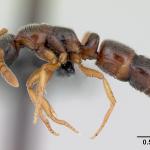The Ponerinae are a phylogenetically primitive subfamily (Hölldobler & Wilson 1990). All castes of the two ponerine genra found in Britain, Ponera and Hypoponera, are readily distinguishable from other British ants by the constriction between the first and second segments of their gasters. Ponerines are also the only ants in Britain with female castes that possess both a single-segmented petiole and a sting.Workers and queens of Ponera differ from those of Hypoponera in the form of the subpetiolar process (figured for both species by Bolton & Collingwood 1975, Collingwood 1979, and Czechowski et al. 2002). Males of Ponera are winged, whilst those of Hypoponera are wingless.The small light to dark brown workers have minute eyes and, like the generally larger queens, a well-developed sting. Pontin (2005) notes that specimens may be found in suitable habitat by sieving moss or using baits of minced meat, whilst Jones (2004) has collected the species from grass by suction sampling.
Ponera coarctata reaches the northern limit of its range in Britain. Here, records indicate that it is restricted to southern England and the south-east coast of Wales. It occurs in the Channel Islands but is not known from Ireland. Although a number of new British sites have been added for the species since it was last mapped by Barrett (1979), it probably remains under-recorded due to its cryptic habits. The map shows records for Ponera coarctata agg and may include some P. testacea records.
Elsewhere, P. coarctata occurs throughout central and southern Europe, also in southern parts of eastern Europe and in north-west Africa. Records from Asia Minor, the Caucasus and the Kopet-Dag Mountains may also refer to this species (Czechowski et al. 2002; Csõsz & Seifert 2003).
Not listed in Shirt (1987), but included by Falk (1991) as Notable B (Nb).
May be found in a variety of warm, sheltered habitats, including open stony ground, grassland, landslips, crumbling cliffs and open woodland. In urban areas it occurs on waste ground and in scrub and large gardens. It appears to favour damp soils (Collingwood 1979; Falk 1991; Pontin 1996).
Winged males and females have been recorded in August and September.
Nests consist of simple passageways running through the soil and with one or more small chambers (Seifert 1996; Pontin 2005). Colonies are small, generally comprising up to 40 workers (although, exceptionally, Leiberg et al. 1995 reported a nest from Germany containing 2 queens, 135 workers, 238 pupae and 23 larvae).The larvae are mobile, and able to feed themselves from invertebrate prey left for them by workers. Pupae are cocooned.
In common with all other ponerines Ponera coarctata is hypogeic and predatory. It probably feeds exclusively on the various developmental stages of ground-dwelling invertebrates. Workers forage singly in soil, litter and moss, and have been found in, and close to, the nests of other ant species (Donisthorpe 1927; Seifert 1996; Czechowski et al. 2002).
2019


